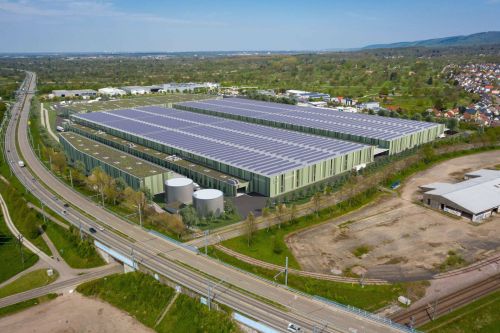On the edge of the concrete jungle
Property management
A downtown location or one in a historic or governmental district generally means a building on a smaller plot, which can mean problems when it comes to parking and deliveries. A different approach to security is also needed, but this can more difficult to provide due to the heavy pedestrian traffic and the potential for unwanted intruders. So why are office buildings even built in locations where operating them – from the owner’s point of view – can be somewhat problematic?
“From talking to our tenants, we know that choosing our building for their offices was influenced by its prestigious location, close to historic monuments, state institutions, courts and ministries,” explains Maksymilian Marcinkowski, the CEO of Senatorska Investment, the developer and owner of the Plac Zamkowy – Business with Heritage building, which is just off pl. Zamkowy in Warsaw’s Old Town. “The uniqueness of the building was also a significant factor – there aren’t so many new buildings in historic areas,” he adds.
‘Razor blade’ parking
The opportunities for parking in the building and in its immediate area are often at the top of the checklist of tenants looking for a city centre office. The reason is simple – all businesses require car access in order to function. And even if by some strange quirk a company can do without this, it will not necessarily be the case for its guests. And in the centres of every major city there is a shortage of vacant parking spaces (even when there are huge public car parks in the neighbourhood). This is why property managers have developed the practice of ‘renting’ parking spaces in other buildings that have vacant spaces. In addition to its own underground car park, Plac Zamkowy – Business with Heritage also has an agreement with a neighbouring hotel, which can provide it with more parking spaces if necessary. “This kind of shared parking system, which optimises the use of the available spaces, is being adopted for more and more buildings,” reveals Grzegorz Dyląg, the head of the asset services business space department at Cushman & Wakefield.
Plans are also being mooted for the introduction of a Smart City system to Warsaw, which would enable buildings to regularly communicate to provide information about vacant spaces, which could give a massive boost to parking space sharing. However, not every property owner is willing to allow external drivers onto their properties. “Convenient parking was important for the developers of Plac Bankowy 1 from the very outset. The construction of a two-level car park under the building added almost two years to the project. However, we now have 50 spaces available because of that. A few are usually free, but we do not sublet them to external tenants – we don’t want outsiders entering our building,” insists Anna Olszewska, the manager of the Plac Bankowy 1 building in Warsaw.
Buildings located in inner city centres usually have excellent transport links due to the public transport available, while most managers are actively engaged in supporting alternative modes of transport for their tenants. “For example, a city bike station would not be suitable here, and besides, there’s no need for this because there’s another one nearby – but we do have a place for bicycle racks for tenants in the courtyard, and in the underground car park we have changing rooms and showers for cyclists,” adds Anna Olszewska.
Plac Zamkowy – Business with Heritage also has a parking area for bicycles and scooters. “At the moment, we are negotiating with Warsaw’s city authorities to introduce an electric scooter system with stations at major transport hubs and at the office buildings managed by us,” reveals Grzegorz Dyląg of Cushman & Wakefield. “We already have an operator who’s ready to organise the entire undertaking. This idea still involves some organising, so it’s difficult to talk about specific dates or locations. However, I can tell you that the system will feature scooters plugged into racks, so when they’re parked they won’t block the pavements,” he insists.

“Small, luxurious, centrally located office buildings with a solid tenant mix are a superb product that can be quickly and profitably sold,” claims Grzegorz Dyląg of Cushman & Wakefield
Small plots – big problems
Many of the problems in city centres stem from the small plots the buildings stand on, where it’s difficult to open common areas up. Managers are, nonetheless, coping quite well with this problem. “Repairs or maintenance work on the buildings can be a fraught issue. All the activities related to them, such as assembling the scaffolding and bringing in waste containers, must be agreed upon with the owner of the adjacent space, which is usually the city. But we have very good relations with the city authorities. The secret is simple: don’t do anything at the last minute – and don’t do anything at a push,” claims Grzegorz Dyląg.
With restrictions on vehicular traffic being the norm in inner cities, everyday deliveries as well as less regular activities, such as renovations and removals, can become rather challenging. “The densely built-up area and central location of the building are certainly a challenge. Deliveries as well as all other activities have to be carried out at night or in the early hours of the morning,” points out Maksymilian Marcinkowski.
Sometimes, however, more unusual activities require a degree of creativity. “When one of our tenants volunteered to provide yoga classes for the building’s users, we arranged some suitable place in a corridor. This is an option for cold or rainy days, because on warm days the group goes to the other side of the road to exercise in the Saxon Gardens,” explains Anna Olszewska.
The smaller plots also mean that it’s impossible to provide the meeting points required by fire safety regulations, where the employees of the building are obliged to gather when the fire alarm goes off. “In the case of the Lumen office building, where we have one of our offices, such a place could have only been set up on the other side of ul. Emilii Plater, next to the Palace of Culture and Science. As a result, every two years when fire drills take place, the several thousand users of the office building have to cross a dual-carriageway in order to get a safe distance from the building,” admits Grzegorz Dyląg.
Crowds outside the window
City centres are often arenas for events that attract thousands of people – such as demonstrations, parades, fairs and marathons – and these can represent additional headaches for building managers, although they can sometimes act as a magnet for prospective tenants. “Almost 200 cultural, social and political events are organised on pl. Zamkowy in front of the Royal Castle each year. The square has witnessed many notable events and visits by distinguished individuals, such as by Barack Obama in 2014,” points out Maksymilian Marcinkowski. “Tenants are always given access to the property, and so the obvious restrictions and increased controls dictated by security considerations are actually an advantage of the location of our property – very few people have the opportunity to observe these unusual, sometimes historic events from the windows of their own office,” explains the CEO of Senatorska Investment.
“Due to our location in the very centre, we increase our security during large public gatherings, such as on New Year’s Eve. The usually open courtyard of the building is then closed off and monitored, not only by our security guards but also by the police. As soon as the afternoon of January 31st arrives, all the guests of the office building and its restaurants must pass through body scanning security gates. Furthermore, we have also insured the property against any damage resulting from such events, although we have not had to use this so far. We have also invested in protecting the external façades – the walls are coated in a special anti-graffiti layer made of natural sandstone and granite,,” explains Anna Olszewska of Plac Bankowy 1.
Damage by vandals or potential intruders, of whom there is no shortage of in city centres, can be reduced by the visual monitoring of the real estate. According to property managers, the systems for doing so used in the commercial real estate sector are being increasingly borrowed from buildings that require special surveilance, such as airports and metro stations. “At night, office buildings are now being monitored by cameras that detect movement and sources of heat which are even able to show the facial features of people passing by. I have recently seen a monitoring system tested that was able to detect the presence of an unattended package – if an object with certain dimensions remains in a stationary position for a long time, the system triggers an alarm. Such devices are the future of building security,” predicts Grzegorz Dyląg of Cushman & Wakefield.

“We know our tenants were influenced in their choice of offices in our building by its prestigious location, close to historic monuments, state institutions, courts and ministries,” says Maksymilian Marcinkowski of Senatorska Investment
Under protection
Anyone who takes over the management of a historic building is beset by an array of challenges – since even the tiniest interference with the appearance or structure of the building requires the consent of the conservation office. “For example, you can’t put any slogans or logos on the exterior – and not only does this include the façade but also the window openings. Restaurant signs can only be positioned in specific places, and the typeface and colour of the font also has to be approved by the conservation office,” admits Anna Olszewska.
Thus the Plac Bankowy 1 building she manages has an additional curator – it is under the artistic supervision of distinguished set designer and Oscar winner Allan Starski. He is responsible for the interior design throughout the entire building, the office section and the common space, including the illuminated logo above the entrance to the car parks. All the plastic elements used in it must first be approved by him. “This applies not only to the interior design, but also to the attire of the receptionists, which have been designed by his wife, Wiesława Starska. From this May, specially designed clothes will also be worn by the cleaning staff, and this could also be the case for the maintenance staff in the future,” reveals Anna Olszewska.
Prestige has its price
Returning to the question posed at the beginning of the article: since office buildings in densely built-up, historic city centres generate more problems for managers and tenants, why are they built? The answer is simple: all you need to do is ‘follow the money’ and think about such a real estate as an investment product. “Small, luxurious, centrally located office buildings with a solid tenant mix are a superb product that can be quickly and profitably sold,” insists Grzegorz Dyląg of Cushman & Wakefield.






















































